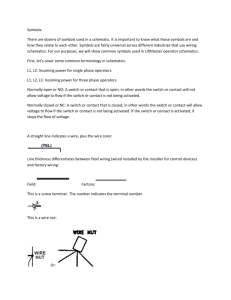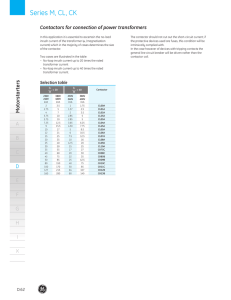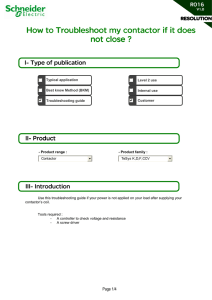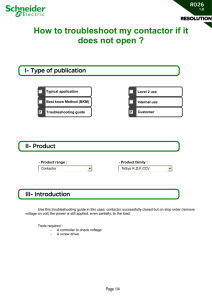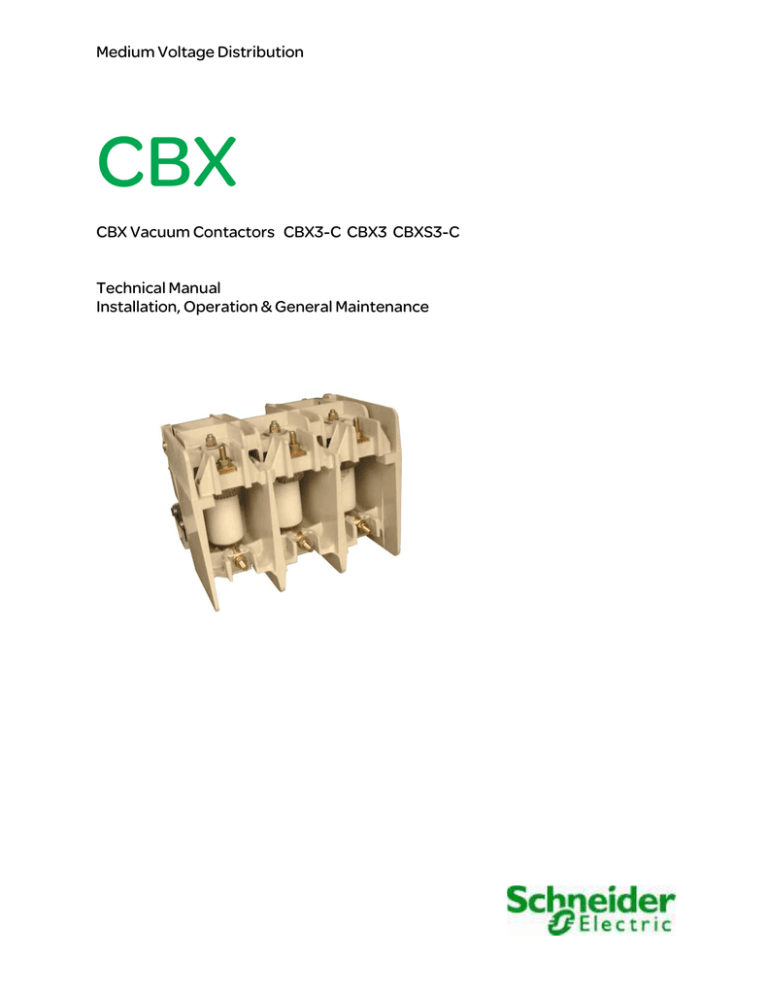
Medium Voltage Distribution
CBX
CBX Vacuum Contactors CBX3-C CBX3 CBXS3-C
Technical Manual
Installation, Operation & General Maintenance
CBX
•
•
•
•
Any operator must read and respect in all case this technical manual.
Installation, comissionning and maintenance should only be conducted by qualified people.
Before installation, check that data in rating label match with the application.
Accidental contact with energized components or wiring can cause shock, burn or
electrocution: turn off power supplying this equipment and control voltage sources before any
work on contactor.
NTV112 - 5E (CPX)
2
CBX
1.
SAFETY INSTRUCTIONS................................................................................................................................................4
1.1
COMPLIANCE WITH INSTRUCTIONS IN THIS MANUAL ......................................................................................................4
1.2
INSTALLATION ..........................................................................................................................................................4
1.3
OPERATION & MAINTENANCE .....................................................................................................................................4
1.4
APPARATUS/TASK/SKILL LEVEL SCHEDULE FOR W ORKING ON THE APPARATUS ..............................................................5
2.
OPERATION & GENERAL INFORMATION ....................................................................................................................6
2.1
GENERAL INFORMATION ............................................................................................................................................6
2.2
DESCRIPTION & OPERATION ......................................................................................................................................8
3.
INSTALLATION & PRE-COMMISSIONING TESTS ......................................................................................................10
3.1
UNPACKING ...........................................................................................................................................................10
3.2
CRITICAL ITEMS DURING UNPACKING AND INSTALLATION .............................................................................................10
3.3
INSTALLATION ........................................................................................................................................................11
3.4
PRE-COMMISSIONING TESTS ....................................................................................................................................12
3.5
ROUTINE SITE VOLTAGE TEST .................................................................................................................................12
4.
MAINTENANCE .............................................................................................................................................................14
4.1
MAINTENANCE ........................................................................................................................................................14
4.2
MECHANICAL & ELECTRICAL LIFE .............................................................................................................................14
4.3
VACUUM SWITCH CONTACT W EAR CHECK ..............................................................................................................15
4.4
W IRING DIAGRAMS (EXCEPT CBXS3-C : SINGLE PHASE) ............................................................................................15
5.
AUXILIARY SWITCHES.................................................................................................................................................16
5.1
GENERAL INFORMATION ..........................................................................................................................................16
5.2
AUXILIARY CONTACT BLOCKS ..................................................................................................................................16
5.3
CONTACT OPERATION .............................................................................................................................................17
5.3
CONTACT OPERATION .............................................................................................................................................18
5.4
AUXILIARY SWITCH MAINTENANCE ............................................................................................................................18
6.
FAULT FINDING ............................................................................................................................................................19
6.1
CONTACTOR WILL NOT CLOSE AT ALL WHEN COILS ARE ENERGISED ..............................................................................19
6.2
CONTACTOR CLOSES AND IMMEDIATELY REOPENS ......................................................................................................19
6.3
CONTACTOR CLOSES BUT MOTOR WILL NOT RUN ........................................................................................................19
6.4
CONTACTOR CLOSES - BUT STOPS AT “TIPS TOUCH” I.E. NO OVERTRAVEL .....................................................................19
7.
CBXS3-C CONTACTORS (SINGLE PHASE) ................................................................................................................20
8.
LATCH-IN DEVICE.........................................................................................................................................................21
8.1
MAINTENANCE OF LATCH-IN MECHANISM...................................................................................................................21
8.2
LATCH-IN DEVICE AND SETTING ...............................................................................................................................21
8.3
IN THE EVENT OF A MALFUNCTION OF THE LATCH ........................................................................................................23
9.
SPARE PARTS LIST......................................................................................................................................................25
10. ANNEX ...........................................................................................................................................................................26
NTV112 - 5E (CPX)
3
CBX
1.
Safety Instructions
1.1
Compliance with Instructions in this Manual
The Purchaser/User should comply with the instructions and information given in this document and ensure that all
personnel to be associated with the apparatus supplied under this contract are made familiar with the information
contained herein.
1.2
Installation
The Purchaser/User should ensure that the apparatus supplied is correctly installed in a suitable location by
technically qualified and competent persons.
Apparatus supplied as loose components, devices or sub-assemblies could, when energised, constitute a safety
hazard. The Purchaser/User should ensure that such apparatus is installed in a secure location and that adequate
safety information is provided to all personnel to be associated with it.
1.3
Operation & Maintenance
1.3.1 Guidance Notes for Users on the Safety of Personnel
The rules for ensuring the safety of personnel can be summarised as follows:
■
■
During Normal Use ensure that the plant operators:
□ are fully conversant with all controls, particularly those for emergency shutdown.
□ comply with safety warning notices and keep all enclosures shut
□ are trained to recognise signs of maloperation and know what action to take in the event of trouble or
difficulty.
During Maintenance, Testing etc. ensure that only technically competent and authorised persons are permitted
to carry out work and that they:
□ comply with statutory requirements.
□ are fully conversant with the apparatus and the system of which it is part, and recognise the safety hazards
which could arise, e.g. back feed.
□ isolate the apparatus completely, where possible, before opening enclosures and prove it to be dead before
starting work. Precautions must be taken to ensure that the isolated apparatus cannot become live whilst
any work is being carried out.
□ comply with safe working procedures for the safety of themselves and others, including the use of
temporary barriers and warning notices.
□ are conversant with the information provided, particularly on matters relating to safety.
□ recognise the hazards which can arise when working on live apparatus and take all the necessary
precautions.
□ functionally check the apparatus and then mechanically and/or electrically test it in accordance with this
manual and good working practice before putting the apparatus back in service.
□ take account of the possibility that the apparatus may have been modified without proper reference to the
manufacturer and take extreme caution at all times before, during and after and work is carried out.
If there is any doubt as to the correct and safe method of working then further assistance should be sought from
Schneider Electric
NTV112 - 5E (CPX)
4
CBX
1.3.2 Skills Required for Specific Tasks
To ensure that the apparatus is safe for use under normal healthy plant operating conditions:
■
it has been designed and tested in accordance with relevant European and International standards.
■
information is provided in this manual about the conditions necessary for safety and about any hazards which
are reasonably foreseeable during normal use, together with precautions to be taken to counteract them.
However, the Purchaser/User should ensure that the apparatus is maintained in a safe condition, and if technically
competent and authorised personnel have to gain access to apparatus which is not made completely safe as
recommended, everyone under whose authority these persons act should ensure that appropriate safety
procedures are generated and complied with.
The apparatus covered in this manual has been allocated the Apparatus Grade stated above. Reference to the
Apparatus/Task/Skill level schedule [1.4] enables the user to select personnel to carry out specific tasks requiring
access to the apparatus.
1.4 Apparatus/Task/Skill Level Schedule for Working on the Apparatus
The apparatus can be supplied as loose items, sub-assemblies etc., for which the purchaser/user is responsible for
assembly etc. [1.2]. The skill level required to work on this equipment can be best described as the following :
Authorised and competent staff (e.g. Electrician, Commissioning Engineer) with a HIGH degree of electrical
expertise, trained to work on live apparatus and fully conversant with the apparatus and the system of which it is
part.
If additional information relating to the apparatus is required please contact : Schneider Electric
NTV112 - 5E (CPX)
5
CBX
2.
Operation & General Information
2.1 General Information
This vacuum contactor was manufactured by;
Schneider Electric
A contactor is primarily a three phase switching device, although single phase units are also available, used
primarily in motor starting/reversing and capacitor bank switching applications. Each phase has a separate
Vacuum Switch which switches at the first available current zero.
2.1.1 Contactor Front View
Armature
Moulding
Pivot Point
Economy resistor
Closing coils
Auxiliary switches
Stop pin
Opening Springs
Fixing holes
Steel Mounting
Plate
2.1.2 Contactor Rear view
NTV112 - 5E (CPX)
6
CBX
Phase assembly & nyloc nuc
Main Terminals
Moulded
Terminal Bar
Main Moulding
Main Terminals
Vacuum
Switches
NTV112 - 5E (CPX)
7
CBX
2.2 Description & Operation
As shown in [2.1.1 & 2.1.2], the Contactor comprises Main and Armature mouldings with two Pivot Points, a Steel
Mounting Plate, three Vacuum Switches( one in a single phase unit), two Opening Springs, two Closing Coils, an
Economy Resistor and one or two Auxiliary Contact Blocks.
2.2.1 Closing Coils Un-energised
In this condition the opening springs acting against the centre limb of the armature moulding hold the vacuum
switches in the normally open position (main circuit off).
2.2.2 Closing Coils Energised
Energising the closing coils attracts the armature which compresses the opening springs. The armature movement
is transmitted through the pivot points, allowing the vacuum switches to close under the effect of atmospheric
pressure which acts on the bellows inside the vacuum switches (main circuit on). The vacuum switches will remain
closed as long as the closing coils are energised. The armature moulding moves further than necessary for switch
closure providing overtravel which accommodates contact wear and, on opening, provides kinetic energy to break
minor contact welds which may occur under severe operating duty.
The energy required to close the contactor is considerably more than the energy required to maintain a closed
position. On initially energising the closing coils a high current flows through the coils. After a short delay an
economy resistor is automatically brought into the circuit by the contactor’s own normally closed, extra-late
opening auxiliary contact. This reduces the current in the closing coils which allows their continuous operation
without over heating. The closing coil rating enables satisfactory operation of the contactor in cubicles with internal
temperatures of up to 65°C. For use in temperatures higher than this, contact Schneider Electric. Contactors may
be supplied fitted with closing coils and economy resistors suitable for d.c. or full wave rectified single phase a.c.
supply voltages as required.
2.2.3 Closing Coils De-energised
When the closing coils are de-energised the opening springs will act on the armature moulding causing the
vacuum switches to open. The vacuum switches provide a sealed gas-free environment making the switching
operation unaffected by external conditions. Once the vacuum switch contacts have separated arcing occurs until
the first available current zero, at which time the current is commutated.
2.2.4 Auxiliary Contacts
One or two type auxiliary contact blocks can be provided giving a maximum of 10 (ten) contacts available for
customer use (5NO+5NC) in magnetically held type and a maximum of 12 (twelve) contacts (6NO+6NC) in
mechanically latched type.
NTV112 - 5E (CPX)
8
CBX
2.2.5 Main Terminals
The main terminals consist of M10 bolts for attachment of cables or busbars. For advice on cable/busbar
connection see [3.3]. The maximum torque applicable for these terminals is 40 Nm and must not be exceeded.
Nut M10
Spring washer M10
Plain washer M10
M10 x 30 LG
TOP TERMINAL
M10 x30 LG
Plain washer
M10
Spring washer M10
Nut M10
LOWER TERMINAL
The maximum width of the lead terminal connexions, bars or crimps is 35 mm.
NTV112 - 5E (CPX)
9
CBX
3.
3.1
Installation & Pre-commissioning Tests
Unpacking
Contactors may be supplied as separate units, or mounted with other equipment. When supplied as separate
units, care must be taken during unpacking.
After removing the packing material, examine the contactor and packing material for broken or missing parts. The
carriers and suppliers should be notified of the breakages within three days of delivery.
These together with any other evidence should accompany communications with the insurance company and the
suppliers. The particulars on the rating plate of the equipment must be quoted in all correspondence.
3.2
Critical Items During Unpacking and Installation
3.2.1 Do not attempt to lift the contactor by means of the auxiliary contact blocks, or latch mechanisms
shown in positions below marked X.
Ha ndling Areas Using
moulding only
Ha ndling Areas Using
moulding only
Handling Areas Using
moulding only
3.2.2 Take care when fitting cables or busbars to the main terminals that the terminations do not
damage, deform or restrict movement of the contactor. Particular care should be taken when
two or more cable terminations are fitted onto a single terminal.
3.2.3 Everything surrounding the contactor (i.e. frames, enclosures, components, power and control
cables) must be clear of the paths of the moving parts of the contactor. Nothing should be
allowed to rest on top of the armature moulding or interfere with the normal operation of the
moving parts of the contactor.
3.2.4 Ensure that nothing interferes with adequate air flow over the contactor, particularly around the
coils and economy resistor.
3.2.5 It is not recommend that additional components are added to the contactor e.g. rectifiers,
indicators, etc.. However, if components are added, checks must be made to ensure that they do
not have any adverse effect on the operation of the contactor.
NTV112 - 5E (CPX)
10
CBX
3.3
Installation
It is recommended that the contactor be mounted with the axes of the vacuum switches vertical and with their
moving contacts at the top. Two M10 x 1.5 fixing holes are provided on each side of the contactor in the turned up
outer edges of the steel mounting plate, which must be used for the mechanical mounting of the contactor. The
maximum torque applicable for these terminals is 40 Nm and must not be exceeded.
When installing and cabling, ensure that an air gap of at least 64mm for 7,2kV and 77mm for 12kV systems, is
maintained between live main circuit contactor parts and earth control circuits.
It may, of course, be necessary to increase these dimensions if the contactor and associated equipment
have to meet a particular impulse withstand voltage.
General Arrangement of Contactor
Mounting holes
Theses dimensions are relatives to the optional mechanical latch.
NTV112 - 5E (CPX)
11
CBX
3.4
Pre-commissioning tests
It is good practice to subject vacuum switches or contactors to pre-commissioning tests.
3.4.1 Check for the presence of loose screws, swarf or other material in the gaps between
closing coil pole pieces and the armature plate
3.4.2 Check contactor operation at 75% of the control voltage after installation, including
cables or busbars, but before applying full control voltage and power.
3.4.3 Perform routine site voltage test. [3.5]
3.4.4 Perform auxiliary maintenance checks [5.4]
It is also advisable to test vacuum switches and contactors under the following circumstances:
3.5
■
If the contactor or switch has been standing for 5 years or more without use - either in storage or in service.
■
In special applications where the switch is in use for long periods without breaking current and without normal
voltage across the contacts when switched off.
■
After a main circuit fuse has operated.
Routine Site Voltage Test
The following test should be carried out by using an a.c. test set of limited rating e.g. 2 to 4kVA, on which the
voltage is continuously variable from zero up to the maximum required for that particular switch. Return the
contactor to the supplier if the test is not successful.
Note :Applying very high voltages to open vacuum switches may generate harmful levels of X radiation.
However emission of X radiation is negligible at the specified test voltages.
3.5.1 Connect output leads of the test set across the open gap of each vacuum switch in
turn.
3.5.2 Slowly raise the voltage from zero to the specified test value taking approximately one
minute to reach full voltage. During this stage any discharge or test set tripping should be
ignored unless it proves impossible to reach the full specified voltage within two minutes.
3.5.3 Hold the voltage at the specified test value for one minute.
Note: On reversing applications and on applications with VS3-C vacuum switches no discharge or test
set tripping can be tolerated whilst the voltage is being slowly raised to, and held for one minute at the
specified test voltage.
NTV112 - 5E (CPX)
12
CBX
Contactor
Type
Vacuum
Switch Type
CBX3-C/CBXS3-C
CBX3
VS3-C
VS3
Nominal
A.C. Test Voltage
D.C. Test Voltage
System Voltage
45/65 Hz
(Test in both polarities)
kV
12
7,2
kV
22
22
kV
22
22
Note : The codings given to contactors in the above table have additional suffix letters and numbers in their references.
When carrying out a.c. high voltage tests, current monitoring facilities are not usually available and in any
event the leakage currents can be misleading due to the presence of currents associated with the
vacuum switch capacitance.
When carrying out d.c. high voltage tests, current monitoring facilities usually are available. If any doubt exists
about the vacuum switch dielectric to pass the routine site test procedure given above, an additional criterion can
be applied where the leakage current should not exceed 150 microamps at the relevant test voltage given in above
table. However, before rejecting any vacuum switch which is apparently outside the limit, it should be ensured that
the leakage current is due to faulty switch dielectric and not due to dirt etc. on the outside of the vacuum switch
envelope.
NTV112 - 5E (CPX)
13
CBX
4.
Maintenance
4.1 Maintenance
These contactors are extremely reliable and only slight maintenance is normally required. The following table
outlines recommended maintenance intervals.
After
Infreque
Every
Every
PreMain
nt
100,000 250,000
Every 5
Installation commissi
Fuse Switchin
Operatio Operatio
Years
on
Operatio g (< 1
ns *
ns *
n
year)
[3.4.1] Contactor Operation
■
[5.3 & 5.4] Auxiliary Contacts
[4.2] Vacuum Switch Wear
=< 400A ψ
[3.5] Vacuum Switch Voltage Test
■
■
■
■
■
■
■
■
■
■
■
■
■
■
■
ψ
Assuming a normal starting peak of six times full load current when controlling a squirrel cage induction motor.
*
These totals are only for ELECTRICAL operations as the Vacuum switch assemblies will mechanically operate
for the life of the contactor.
4.2 Mechanical & Electrical Life
The contactor has a design life of 3,000,000 mechanical operations. Electrical life depends upon the type of
vacuum switch fitted and the level of current to be switched. Provided that the vacuum switch contact wear does
not exceed the maximum permissible [4.2.1] then contactor will continue to function correctly.
NTV112 - 5E (CPX)
14
CBX
4.3
Vacuum Switch Contact Wear Check
After isolating the main circuit of the contactor, close the armature by
energising the coils and insert the wear gauge DRC001528-02
provided underneath the washer on top of each phase (as indicated
above).
With the gauge in position, slide it from back to front to gain a feel for
the movement. If the gauge is trapped or tight fitting i.e. phase
assembly, washer, and Nyloc nut also move, this indicates that the
switch contacts are worn and the switch is close to or at the end of its
electrical life. If one or more switches indicate worn contacts, all
three vacuum switches must be replaced.
Important : Remember to remove the gauge after checking
for wear !
Note : A switch assembly is worn out when each contact has been
reduced in thickness by 0.25mm i.e. a total of 0.5mm per pair of
contacts in a switch.
4.4
Wiring Diagrams (except CBXS3-C : single
phase)
Magnetically held
See Electric diagram contactor DRC002213-01 (DC) and DRC00221303 (AC) in annex.
With mechanical latch
See Electric diagram contactor DRC002213-02 (DC) and DRC00221304 (AC) in annex.
NTV112 - 5E (CPX)
15
CBX
5.
Auxiliary Switches
5.1 General Information
Auxiliary switches are provided as units of 4 (or 6) double - break, silver faced contacts with a moulded bar carrying
the moving contacts and a fixed moulding carrying the fixed contacts.
The last two contacts are used as ‘Late Breaks’ for the contactor’s economising circuit. These contacts will
discolour in time and is not normally detrimental. However their operation is critical to the correct functioning of the
contactor and periodic inspection is vital [4.1].
Contact arrangement can be readily changed, i.e. - normally open to normally closed or vica - versa.
5.2 Auxiliary Contact Blocks
Magnetically held
NTV112 - 5E (CPX)
16
CBX
With mechanical latch
NTV112 - 5E (CPX)
17
CBX
5.3 Contact Operation
The normal movement of the moving contact carrier is 6mm ± 0.5mm contact stroke plus 3mm ± 0.5mm overtravel.
The extra late opening economising contact [5.2.5] should have a gap of 1.5 to 1.8mm with the contactor fully
closed. A supplement explaining contact adjustment and replacement is available from your supplier upon request
although in normal use this should not be necessary.
5.4 Auxiliary Switch Maintenance
The silver faced contacts require little attention but should be kept free of dust and dirt; the black tarnish which may
appear need not be removed as it does not impair conductivity.
5.4.1 Examine moving parts for side play, badly worn pivots etc., which indicate that the auxiliary
switch should be replaced.
5.4.2 Check that the pivot securing nuts are tight.
5.4.3 Operate the contactor to check that the contacts have satisfactory wipe and break and that
movement is free.
5.4.4 Contacts which are badly worn or burnt through the silver facing to the copper must be replaced.
5.4.5 If it is found necessary to replace a moving spring, the coils of the spring must be turned on
edge to extract it through the slot in the side of the moving contact carrier.
Where reliability of operation is particularly critical - e.g. continuous processes, mine winding
installations, etc., inspection of the auxiliary switches is recommended at intervals of approximately
100,000 operations.
NTV112 - 5E (CPX)
18
CBX
6. Fault Finding
In cases of apparent contactor malfunction carry out the following checks after the isolation of the main circuit.
Note A: As the contactor relies on atmospheric pressure acting on the switch bellows, loss of vacuum in
one or more switches on the 7,2kV and 12kV contactors will possibly prevent closure depending
on actual supply voltage and whether the coils are cold or hot.
Note B: In cases of burnt out coils, this may be due to a failure to economise [5.3 & 5.4].
Note C: Do not adjust nyloc nuts on top of the phase assemblies, pivot point screws and nuts, stop pin locking nut
or opening springs. It is unlikely that any of these will have altered to the extent of causing malfunction of a
contactor which was previously satisfactory.
6.1 Contactor will not close at all when coils are energised
■
■
■
■
■
■
Check power supply to closing coils
Check auxiliary switch drive and pivots are not broken, badly worn or screws loose.
Check extra late opening economising contact is operating satisfactorily [5.3 & 5.4].
Check that all switches have vacuum using the site voltage test [3.5].
Manually assist closure with coils energised. If not possible to close with moderate force, check that sufficient
voltage (see rating label) appears across the coil terminals.
Check that rectifier (if applicable) has not became half-wave, or coils faulty.
6.2 Contactor closes and immediately reopens
■
■
■
Check extra late opening economising contact is operating satisfactorily [5.3 & 5.4].
Check for the presence of loose screws, swarf or other material in the gaps between closing coil pole pieces
and the armature plate.
Check that economy resistor is not open circuit.
6.3 Contactor closes but motor will not run
■
■
■
Check fuses, if fitted, and any other protection equipment
Check with vacuum switch contact wear gauge if contactor is nearing the end of its life.[4.2.1]
Check that all switches have vacuum using the site voltage test [3.5].
6.4 Contactor closes - but stops at “tips touch” i.e. No overtravel
■
■
■
Check extra late opening economising contact is operating satisfactorily [5.3 & 5.4].
Check the voltage across the closing coils.
Check for the presence of loose screws, swarf or other material in the gaps between closing coil pole pieces
and the armature plate.
NTV112 - 5E (CPX)
19
CBX
7.
CBXS3-C Contactors (Single Phase)
The information given elsewhere in this manual is, in general, also applicable to the single phase
contactors except where reference is made to more than one phase or vacuum switch and to the use of
closing coils and economising contacts.
In particular the following information applies to the specific contactors listed below :
Wiring Diagram for CBXS3-C
■
Magnetically held
□
■
□
■
■
■
See Electric diagrams contactor DRC002323-01 (DC) and DRC002323-03 (AC) in annex.
Mechanically latch
See Electric diagrams contactor DRC002323-02 (DC) and DRC002323-04 (AC) in annex.
No economising resistor is fitted.
Extra late opening economising contacts are not fitted (irrespective of the closing coil supply voltage).
No provision is made for adjustment of the main opening springs.
NTV112 - 5E (CPX)
20
CBX
8.
Latch-in Device
8.1 Maintenance of Latch-in Mechanism
No maintenance is required for the latch-in mechanism, beyond an occasional light application of
molybdenum disulphide loaded grease to the sliding parts.
8.2 Latch-in Device and Setting
8.2.1 Latch in Close position
M4 GRUB
SCREW
ROLLER
PROP
CLEVIS
NTV112 - 5E (CPX)
21
CBX
8.2.2 Latch in open position
NTV112 - 5E (CPX)
22
CBX
8.3 In the event of a malfunction of the latch
The following points should be examined:
8.3.1 Check freedom of moving parts. (It is possible that the alignment of the whole latch assembly
may have been disturbed during transit).
8.3.2 Check with a clock gauge, the set-back of the clevis holding the roller behind which the prop is
located. (ie. its free movement in relation to the latch body in the horizontal direction, from the
contactor coil energised condition to the latched-in, coil de-energised state).
This set-back should be between 0.2mm and 0.4mm. The set-back can be adjusted by slackening the
screws fixing the whole latch assembly to the contactor coil support angle, and adding (to decrease
the set-back) or removing (to increase set-back) slotted shim washers between the collars and the
angle. Retighten screws and recheck set-back.
Coarse adjustment necessitates removal of the latch assembly and screwing the clevis further on to or
off its drive rod in one full turn steps. (The E-clip on the roller pivot pin must be located against the
lower slotted guide plate).
8.3.3 Check prop engagement behind roller. Assuming the set-back is correct (see 8.3.2 above), but the
latch is reluctant to trip, it is possible that the prop is too far into engagement behind the roller.
Conversely, insufficient engagement can result in failure to latch. The engagement can be reset as
follows:
Slacken the locknut on the M4 grubscrew in the prop and adjust this grubscrew until the contactor ust
fails to latch. Unscrew the grubscrew 11/2 full turns from this position so that the prop is further into
engagement behind the roller. Lock with locknut and recheck 8.3.2 above.
8.3.4 Check solenoid tripping action and adjust as follows if necessary.
Three solenoids are available, for nominal voltages of 24 Vdc, 48 Vdc and 110/240 volts ac or dc.
having cold resistances of 3, 14 or 54 ohms respectively. (Coils are marked 24Vdc 5%, 25% or 100%
respectively).
With the contactor latched, there should be a clearance of 0.5mm to 1mm between the outer end of the
prop and the 10mm diameter collar fixed to the trip rod passing through the prop. This dimension can
be adjusted by addition or removal of M3 washers behind this collar.
With the 10mm diameter collar loose on the trip rod, allow the solenoid plunger to retract as far as
possible without forcing. Push in the plunger 1mm from this position and tightly secure the collar to
the trip rod by means of the two grub screws and lock with the locknuts. The collar now acts as a stop
for the lever/plunger assembly. The dimension between the outer end of the plunger and the solenoid
mounting plate should be at least 24mm. Check that the solenoid plunger is not sticking at any stage in
its movement.
NTV112 - 5E (CPX)
23
CBX
Notes:
To ensure correct operation, closing coils and tripping coil must be energised for a minimum of 300
milliseconds. Closing coils and Tripping coil must not be energised for more than 2 seconds.
The supply to the tripping coil providing it is less than 220V d.c. can, if required, be wired through a normally
open contact on the auxiliary contact block.
The closing supply however, should not be wired directly through a normally closed contact on the
auxiliary contact block, as this could cause the closing supply to be disconnected before the
contactor is fully closed.
The use of an auxiliary switch on the vacuum contactor or on the latch (if fitted) to interrupt the contactor coil
supply during the closing action is not recommended unless an intermediate relay with a delay of at least
0.3 seconds is employed.
NTV112 - 5E (CPX)
24
CBX
9.
Spare parts list
CBX3
Closing coils
24 V
48 V
Vdc
60 V
110/125 V
220/250 V
110 V
Vac
120 V
220/240 V
Resistance
24 V
48 V
60 V
Vdc
110 V
125 V
220
250V
110/120 V
Vac
220/230 V
250 V
Equipped auxiliary switch
1NO + 1NC
2NO + 2NC
3NO + 3NC
4NO + 4NC
4NO + 4NC
5NO + 5NC
2NO + 2NC
3NO + 3NC
4NO + 4NC
5NO + 5NC
5NO + 5NC
6NO + 6NC
Graetz Bridge
Varistor
Tripping coils (latch)
24-30 Vdc
48 Vdc
110-240 Vdc
240 Vac
CBX3-C
CBXS3-C
Recomanded
quantity by
contactor
DRC001966-01
DRC001966-02
DRC001966-03
DRC001966-04
DRC001966-05
DRC001966-04
DRC001966-04
DRC001966-05
DRC001966-03
DRC001966-04
DRC001966-06
DRC001966-07
DRC001966-08
DRC001966-07
DRC001966-07
DRC001966-08
2
2
2
2
2
2
2
2
DRC001685-01
DRC001685-02
DRC001685-03
DRC001685-04
DRC001685-05
DRC001685-07
DRC001685-07
DRC001685-04
DRC001685-07
DRC001685-07
-
1 for CBX3/CBX3-C
1 for CBX3/CBX3-C
1 for CBX3/CBX3-C
1 for CBX3/CBX3-C
1 for CBX3/CBX3-C
1 for CBX3/CBX3-C
1 for CBX3/CBX3-C
1 for CBX3/CBX3-C
1 for CBX3/CBX3-C
1 for CBX3/CBX3-C
-
1 set
1 set
1 set
1 set
1 set
1 set
1 set
1 set
1 set
1 set
1 set
1 set
1
1
DRC001584-01
DRC001584-04
L* DRC001584-01 +DRC001584-02 R*
L* DRC001584-01 +DRC001584-03 R*
L* DRC001584-04 +DRC001584-02 R*
L* DRC001584-04 +DRC001584-03 R*
DRC001584-02
DRC001584-03
L* DRC001584-02 +DRC001584-02 R*
L* DRC001584-02 +DRC001584-03 R*
L* DRC001584-03 +DRC001584-02 R*
L* DRC001584-03 +DRC001584-03 R*
ST431-101-137
ST431-201-034
DRC001749-03
DRC001749-02
DRC001749-01
DRC001749-01
1
1
1
1
* L and R are for Left hand side and Right hand side when viewing coils
Replacement of parts should be performed only by qualified personnel.
Always de-energize a contactor and remove it from the equipment before performing any tests, maintenance or
repair.
Please contact Schneider Electric for training course.Use of unauthorized parts in the repair of the equipment,
altering of the design, or tampering by unqualified personnel will result in dangerous conditions : can cause
death, serious personal injury or equipment damage.
NTV112 - 5E (CPX)
25
CBX
10. Annex
■
■
■
■
■
■
■
■
Electrical diagram contactor CBX DRC002213-01 (DC): magnetically held
Electrical diagram contactor CBX DRC002213-02 (DC): with mechanical latch
Electrical diagram contactor CBX DRC002213-03 (AC): magnetically held
Electrical diagram contactor CBX DRC002213-04 (AC): with mechanical latch
Electrical diagram contactor CBXS DRC002323-01 (DC): magnetically held
Electrical diagram contactor CBXS DRC002323-02 (DC): with mechanical latch
Electrical diagram contactor CBXS DRC002323-03 (AC): magnetically held
Electrical diagram contactor CBXS DRC002323-04 (AC): with mechanical latch
NTV112 - 5E (CPX)
26
CBX
NTV112 - 5E (CPX)
Notes
27
© 2011 Schneider Electric - All rights reserved
Schneider Electric
35, rue Joseph Monier
CS 30323
F - 92506 Rueil Malmaison Cedex
RCS Nanterre 954 503 439
Capital social 896 313 776 €
www.schneider-electric.com
As standards, specifications and designs change from time to time, please
ask for confirmation of the information given in this publication.
This document has been printed
on ecological paper.
Publishing: Schneider Electric
Design: Schneider Electric
Printing:
02/2011
NTV112 - 4E

